Pitched Battles 2023-24
This battlepack presents this season’s rules for playing Pitched Battles as part of a matched play event. Each season we will provide a new set of rules that includes grand strategies, battle tactics, realm rules and battleplans. This season, the action continues in Andtor, the Bitter Land.
Contents | ||
Books
| Book | Kind | Edition | Last update | |
 General’s Handbook: Pitched Battles 2023-24 General’s Handbook: Pitched Battles 2023-24 | ||||
 General’s Handbook: Pitched Battles 2023-24 General’s Handbook: Pitched Battles 2023-24 | Expansion | 3 | April 2024 | |
FAQ
| Q: | If I take an enhancement which allows a unit in my army to become a WIZARD (e.g. Arcane Tome), can I include any Nullstone Adornments in my army? |
| A: | No. |
| Q: | If an ability effect triggers when one of the dice rolls in a casting roll is a certain number (for example, the Infernal Enrapturess’s Discordant Disruption ability), should primal magic dice be considered as part of the casting roll? |
| A: | No. Primal magic dice modify the casting roll; they are not part of it. |
| Q: | If a unit in my army is not a WIZARD but has an ability which allows them to automatically cast a spell (for example the Spell in a Bottle enhancement), can I include any Nullstone Adornments in my army? |
| A: | No. |
| Q: | Can an allied unit take a spell from the Lore of Primal Frost? |
| A: | No. |
| Q: | If a HERO is given a Nullstone Adornment, can I give that HERO an artefact of power afterwards? |
| A: | No. |
| Q: | When players roll to see if they receive primal magic dice at the start of the hero phase, do both players roll their dice at the same time? |
| A: | Yes. |
| Q: | Is a primal miscast the same as a miscast? |
| A: | No. A primal miscast occurs instead of a miscast. If an ability has an effect that triggers when a spell is miscast (for example, the Skull Altar’s Witchbane ability), the effect does not apply. |
| Q: | What happens if I use primal magic dice to supplement a casting roll that was made with 3 or more D6 and my roll includes two or more 1s and two or more 6s? |
| A: | The caster suffers a primal miscast and the spell is not successfully cast. |
| Q: | Can Destiny Dice be spent to replace a primal magic dice? |
| A: | No. |
| Q: | How do re-rolls work with primal magic dice? |
| A: | If an ability or effect allows a player to choose whether to re-roll a casting roll, such as a friendly Shrine Luminor’s Cleansing Rituals ability, the player cannot use primal magic dice to supplement that casting roll. If an ability or effect forces a player to re-roll a casting roll, such as an enemy Infernal Enrapturess’s Discordant Disruption ability, the player can still use primal magic dice to supplement that casting roll. |
| Q: | When I pick units to place in reserve using Outflank in the ‘Spring the Trap’ battleplan, can I pick a friendly unit that has an ability that says it cannot be set up in reserve or cannot be set up again, such as Gotrek Gurnisson? |
| A: | No. |
| Q: | When I pick units to place in reserve using Outflank in the ‘Spring the Trap’ battleplan, can I pick a friendly TRANSPORT VESSEL that has units embarked in it to be placed in reserve? |
| A: | Yes, but you must also pick each embarked unit to be placed in reserve too. If you do so, when that TRANSPORT VESSEL is set up on the battlefield, any units that were embarked in it are still embarked in it. |
| Q: | Can units that contain 1 or more models that are WIZARDS – for example, LUMINETH REALM-LORDS Vanari Auralan Sentinels units – be included in the Wizard-finders of Andtor battalion? |
| A: | No. |
| Q: | Is a unit that contains 1 or more models that are WIZARDS – for example, a LUMINETH REALM-LORDS Vanari Auralan Sentinels unit – considered to be a WIZARD if it is picked to be the target of attacks made by an enemy unit in the Wizard-finders of Andtor battalion? |
| A: | Yes, as long as the conditions that make that model a WIZARD are satisfied. For instance, if a Vanari Auralan Sentinels unit has 5 or more models, that unit is considered to be a WIZARD for the purposes of the Magic Hunters ability in the Wizard-finders of Andtor battalion. |
| Q: | If I use an ability to automatically cast a spell with a set casting roll, such as the Scinari Cathallar’s Deep Thinkers ability, but the set casting roll is below the casting value of that spell, is that spell cast or not? |
| A: | No. |
| Q: | If a PRIEST has a Hand-carved Nullstone Icon, how many spells or endless spells can it attempt to unbind or dispel in the enemy hero phase? |
| A: | One. If that attempt is successful, that unit can attempt to unbind another spell or dispel another endless spell, and so on until the attempt fails. |
| Q: | If my general has the Shaman of the Chilled Lands command trait, it knows all of the spells from the Lore of Primal Frost. Can I also pick another spell from a different spell lore for this HERO to know as its spell lore enhancement? |
| A: | Yes. |
| Q: | Can Unique units be given a Nullstone Adornment? |
| A: | No. |
| Q: | Can I summon a WIZARD if my army does not contain any WIZARDS and a friendly HERO has a Nullstone Adornment? |
| A: | Yes. |
| Q: | If I summon a WIZARD that meets the criteria to be an ANDTORIAN LOCUS, can I pick a spell from the Lore of Primal Frost to give to that WIZARD? |
| A: | Yes. |
Getting Started
- First, you need to agree on the points limit for the battle.
- Next, pick 1 faction for your army and consult the Pitched Battles table to see the restrictions that apply when picking your units.
- Then, record the details of your army on your army roster. This includes the grand strategy you have selected, the units you have included and the enhancements you have picked for them.
- Finally, determine the battleplan you will play, making sure that you have read the realm rules before the battle begins. All that remains is to fight the battle itself!
Pitched Battles
Battles fought using this battlepack are Pitched Battles. The following rules apply to battles fought using this battlepack:
1. Points Limit
You and your opponent will first need to agree on a points limit for the battle. The points limit for the battle can be either 1000 or 2000. After you have agreed on a points limit, look it up on the Pitched Battles table below. The table lists the restrictions on what the players can include in their armies.
| |||||||||||||||||||||||||||||||||
2. Pick Your Army
Next, you must pick your army following the restrictions below.| See Pitched Battle Publications 2023-24 for a list of publications whose rules you are allowed to use when picking your army. | ||
Faction
You must pick 1 faction for your army. All of the units in your army must be from a single faction.Battlefield Roles
The Pitched Battles table lists the minimum number of Leader and Battleline units you must include in your army and the maximum number of Leader, Behemoth and Artillery units you can include in your army.Your general must have the Leader battlefield role. A model that has both the Leader and Behemoth battlefield roles counts as 1 Leader and 1 Behemoth in your army. If a unit has both the Battleline and Behemoth battlefield roles, that unit does not count toward the maximum number of Behemoth units you can include in your army.
| Remember that allied units are ignored when determining if the units in the army are from a single faction (core rules, 27.1). | ||
Battalions
You can include core battalions in your army but you cannot include warscroll battalions.Understrength and Reinforced Units
The Pitched Battles table lists how many reinforced units you can include in your army. Only Battleline units can be reinforced twice. You cannot include understrength units in a Pitched Battle army.Allied Units
The maximum number of points that you can spend on allies from your points allowance is shown on the Pitched Battles table. Allied units do not count towards the number of Battleline units in your army. However, they do count towards the maximum number of Leader, Behemoth and Artillery units in your army.Coalition Units
Coalition units do not count towards the number of Battleline units in your army. However, they do count towards the maximum number of Leader, Behemoth and Artillery units in your army. In addition, coalition units are ignored when determining if the units in your army are from a single faction.Endless Spells and Invocations
The Pitched Battles table lists the maximum number of endless spells and invocations you can include in your army. You cannot include the same endless spell or invocation more than once in your army.3. Fill Out Your Army Roster
Once you have picked your army, record the details on your army roster and show it to your opponent before setting up your army at the start of the battle. Your roster must include a list of the units, battalions, endless spells and invocations in your army; what size the units are; which units are in each battalion; the army’s faction; the grand strategy you have picked; which units are allies; and which model is the army’s general.Use the Notes column on the roster to record the command models you have chosen for each unit, the spells and prayers that are known by the WIZARDS and PRIESTS in your army, any artefacts of power you have given to HEROES in your army, and the command trait you have chosen for your general. If your army includes any units that are given keywords when they are set up, such as units with a Mark of Chaos, these keywords must be written down when the unit is added to the roster.
Grand Strategies
When you are filling out your army roster, you can pick 1 grand strategy. Your grand strategy represents what your army is trying to accomplish, and achieving it can make all the difference in a closely fought battle. The rules for how to use grand strategies can be found here.4. To War!
After you and your opponent have filled out your army rosters, it’s time to determine the battleplan that you will use. In this section you will find special rules that apply to battles fought using this battlepack.Pitched Battle Battleplans
The players roll off and the winner rolls a dice. On a 1-3, Battleplan Table 1 is used; on a 4-6, Battleplan Table 2 is used (see below). Then, their opponent rolls a dice to determine which battleplan is used for the game.
| ||||||||||||||||||||||||||||||||||||||
Battle Tactics
Battle tactics are secondary objectives that the armies can attempt to achieve as the opportunity presents itself during the battle. Each battle tactic you pick will give you a new goal for your army to aim for in each of your turns. The rules for how to use battle tactics can be found here.Realm Rules
You must use the Region of War: Andtor, the Bitter Land realm rules.Terrain Features
The Pitched Battles table lists the recommended minimum number of terrain features to be set up on the battlefield. Each terrain feature must be set up more than 3" from the battlefield edge, more than 6" from all other terrain features and more than 3" from all objectives. If it is impossible for a terrain feature to be set up, it is not used.| Some events will have battlefields with terrain features that have been set up before both players arrive at the table, or the position of terrain features may have been predetermined by a third party. If this is the case, the players roll off to determine who is the attacker and defender as normal, with the attacker picking the territory in which they wish to deploy and setting up the first unit. If a faction terrain feature must be set up before any other terrain features and the battlefield has already been set up by a third party, set up that faction terrain feature before territories are determined. | ||
Faction Terrain
Faction terrain features must be set up more than 3" from all other terrain features and more than 3" from all objectives. These restrictions are in addition to the set-up rules in the battletome in which they appear. If it is impossible for a faction terrain feature to be set up, it is not used.Mysterious Terrain
The defender must roll on the Mysterious Terrain table from the core rules (see 28.1.3) to determine additional scenery rules that apply to any terrain features that do not have a warscroll. Roll on the Mysterious Terrain table for each applicable terrain feature after it has been set up.Alternating Deployment
If a battleplan says that the players use alternating deployment, then the players alternate setting 1 unit at a time. The players continue to set up their units until both armies have been set up. If one player finishes setting up their army first, their opponent must set up the rest of the units in their army, one after another.Stealing the Initiative
Do not roll off to determine who has priority in the first battle round. Instead, the player who finished deploying their army first has priority in the first battle round.Realm Rules
Region of War: Andtor, the Bitter Land
The following rules reflect what it is like to do battle in the bitter and frozen lands of Andtor in Ghur. Only the hardiest fighters survive for long amidst this continent’s unforgiving environments.
Special Rules
WIZARD HEROES with a Wounds characteristic of 9 or less that are not Unique gain the ANDTORIAN LOCUS keyword.
Optimal Focus: Like all things Ghurish, Andtorian magic is wild and dangerous, but a wizard who focuses their entire concentration on manipulating it can find their powers amplified beyond expectation.
At the start of the battle round, after priority is determined, the player taking the second turn can pick 1 friendly HERO on the battlefield. If that HERO is an ANDTORIAN LOCUS, they can attempt to cast 1 extra spell and attempt to unbind 1 extra spell in that battle round. If they are not an ANDTORIAN LOCUS, you receive 1 command point that can only be spent to allow that HERO to issue a command.
At the start of the hero phase, both players roll a dice. For each 4+, each player receives 1 primal magic dice. After a player attempts to cast or unbind a spell, or after a player attempts to dispel an endless spell, they can roll 1 of their primal magic dice. If they do so, add the result to the casting, unbinding or dispelling roll. That player can continue to roll additional primal magic dice until the caster suffers a primal miscast (see below) or there are no more primal magic dice to be rolled.
Abilities that allow you to re-roll casting, unbinding or dispelling rolls must be used before primal magic dice are rolled. If you choose to use an ability to re-roll a casting, unbinding or dispelling roll, you cannot use primal magic dice to supplement that roll. At the end of each battle round, any primal magic dice that have not been used are lost.
When a primal magic dice modifies a casting roll, if two or more of the dice in the casting roll and primal magic dice are 1s, the caster suffers a primal miscast instead of a miscast. The spell is not successfully cast, the caster suffers D3+3 mortal wounds and each other unit within 3" of the caster suffers D3 mortal wounds. In addition, the caster cannot attempt to cast any more spells in that phase.
When a primal magic dice modifies a casting roll, if two or more of the dice in the casting roll and primal magic dice are 6s, and the caster did not suffer a primal miscast, the spell is successfully cast and cannot be unbound. In addition, the caster cannot attempt to cast any more spells in that phase and both players receive 1 primal magic dice.
Unique Enhancements
Nullstone Adornments
A Nullstone Adornment is a unique enhancement that can only be taken in an army that does not include any WIZARDS or any units with abilities that would allow a unit to cast spells in the same manner as a WIZARD. You can always take 1 Nullstone Adornment enhancement in such an army. Each time you take a Nullstone Adornment enhancement, you can pick 1 Nullstone Adornment from the table below and give it to 1 HERO in your army that does not have an artefact of power. If a rule allows you to take an extra enhancement, you can take a Nullstone Adornment enhancement as that extra enhancement, but if you do so, you cannot pick the same Nullstone Adornment from the table below more than once, and you cannot give a Nullstone Adornment to a HERO that already has one or that has an artefact of power.Hand-carved Nullstone Icon Skilfully sculpted and inscribed with powerful enchantments, this icon can be held aloft to undo volleys of sorcerous power.The bearer can attempt to unbind 1 spell or attempt to dispel 1 endless spell in the enemy hero phase in the same manner as a WIZARD. Each time the bearer successfully unbinds a spell or dispels an endless spell using this ability, the bearer can attempt to unbind 1 additional spell in that phase. |
Pouch of Nulldust As the bearer releases finely ground nullstone into the air, nearby spellcasters recoil as their control of Andtor’s magic starts to slip away.Once per battle, at the start of the hero phase, you can say that the bearer will use their Pouch of Nulldust. If you do so, until the end of that phase, unmodified casting rolls that include a double 1, double 2 or double 3 are treated as miscasts or, if a primal magic dice was rolled as part of the casting roll, as primal miscasts. In addition, roll a dice for each endless spell on the battlefield. On a 5+, that endless spell is dispelled. |
Polished Nullstone Pebble When a warrior carries this small, almost perfectly spherical and remarkably reflective stone, they repel malevolent magic at the last second.When this unit is picked as the target of a spell or the abilities of an endless spell, you can roll a dice. On a 4+, the caster must pick another unit within 3" of this unit and within range of that spell or endless spell’s abilities to be the target. If, when picking another unit, there are no other units within 3" of this unit and within range, ignore the effect of that spell or the effects of that endless spell’s abilities on this unit instead. |
Realmsphere Magic
You can pick 1 spell from the Lore of Primal Frost for each ANDTORIAN LOCUS in your army instead of picking 1 spell from another spell lore that they know.Lore of Primal FrostANDTORIAN LOCUS only.
| |||||
Command Traits
If your general is an ANDTORIAN LOCUS, you can pick 1 command trait from the following list and give it to your general.Dwellers of the TundraANDTORIAN LOCUS only.
| ||||||
Core Battalions
You can include any of the following core battalions in your army in addition to those found in the core rules and other publications. In addition, you cannot include the same core battalion from those shown below more than once in your army.
|
|
| ||||||||
Grand Strategies
After you have picked your army, you must pick 1 grand strategy from the list below and record it on your army roster. At the end of the battle, if you completed your grand strategy, you score additional victory points as described in the battleplan you are playing.
| ||||||||
Battle Tactics
At the start of your hero phase, you must pick 1 battle tactic from the list below. You must reveal your choice to your opponent, and if your battle tactic instructs you to pick something, you must tell your opponent what you pick. You have until the end of that turn to complete the battle tactic. You cannot pick the same battle tactic more than once per battle.
| |||||||||||
Scoring Sheet

Battleplan Geomantic Pulse 1 1Andtor’s shifting plains beat with frigid power. Now many seek to seize and harness such an energy source to freeze their foes solid. Claim the pulse for your own – or your own warriors may be next. THE ARMIES Each player picks an army and then they roll off. The winner chooses which player is the attacker and which is the defender.THE BATTLEFIELD The defender sets up the battlefield. First, they set up objectives as shown on the map. Then, they set up the recommended number of terrain features shown on the Pitched Battles table.DEPLOYMENT The attacker picks which territory is their territory. The other territory is the defender’s territory. The players then use alternating deployment, starting with the attacker. Each player must set up their units wholly within their territory.THE PULSE At the start of the second battle round, after determining which player will take the first turn, the player taking the second turn picks either objective A or objective B to be the pulse for that battle round. At the start of each subsequent battle round, the objective adjacent to the pulse that has not yet been the pulse becomes the pulse. Only 1 objective can be the pulse per battle round. Objectives cannot be moved in this battle.VICTORY POINTS Each player scores victory points at the end of each of their turns as follows:- Score 1 victory point if you control at least one objective. - Score 2 victory points if you control the pulse. - Score 1 victory point for each objective adjacent to the pulse that you control. - Score 2 victory points if you completed the battle tactic you picked that turn. GRAND STRATEGY Each player scores 3 victory points at the end of the battle if they completed their grand strategy.BATTLE LENGTH The battle lasts for 5 battle rounds.GLORIOUS VICTORY The player with the most victory points at the end of the battle wins a major victory.If the players are tied on victory points at the end of the battle, then the player who completed the most battle tactics wins a minor victory. If both players completed the same number of battle tactics, then if only one player completed their grand strategy, that player wins a minor victory. If both players or neither player completed their grand strategy, the battle is a draw. 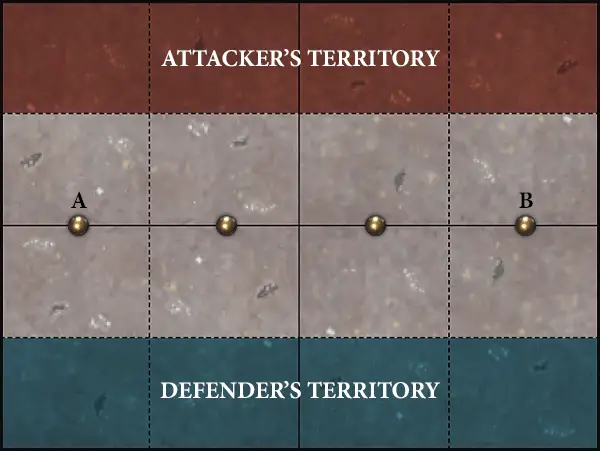 | ||
Battleplan Nexus Collapse 2 2The cold magic of Andtor is as much of an enemy as your rivals – and no less deadly. While the unclaimed land offers many sites of power to be seized, beware the flaring of the continent’s nexus points. This land is hostile, and its energy has a bitter will all of its own... THE ARMIES Each player picks an army and then they roll off. The winner chooses which player is the attacker and which is the defender.THE BATTLEFIELD The defender sets up the battlefield. First, they set up objectives as shown on the map. Then, they set up the recommended number of terrain features shown on the Pitched Battles table.DEPLOYMENT The attacker picks which territory is their territory. The other territory is the defender’s territory. The players then use alternating deployment, starting with the attacker. Each player must set up their units wholly within their territory and more than 9" from enemy territory.INSTABILITY At the start of each battle round after the first, after determining which player will take the first turn, the player with the fewest victory points can choose to collapse up to 2 objectives. If both players are tied on victory points, the players roll off and the winner can choose to collapse 1 objective.Roll a dice for each unit within 6" of any collapsed objectives. On a 4+, that unit suffers D3 mortal wounds. Once all rolls have been made for those units, remove all collapsed objectives from the battlefield. VICTORY POINTS Each player scores victory points at the end of each of their turns as follows:- Score 1 victory point if you control at least one objective. - Score 1 victory point if you control two or more objectives. - Score 1 victory point if you control more objectives than your opponent. - Score 2 victory points if you completed the battle tactic you picked that turn. GRAND STRATEGY Each player scores 3 victory points at the end of the battle if they completed their grand strategy.BATTLE LENGTH The battle lasts for 5 battle rounds.GLORIOUS VICTORY The player with the most victory points at the end of the battle wins a major victory.If the players are tied on victory points at the end of the battle, then the player who completed the most battle tactics wins a minor victory. If both players completed the same number of battle tactics, then if only one player completed their grand strategy, that player wins a minor victory. If both players or neither player completed their grand strategy, the battle is a draw. 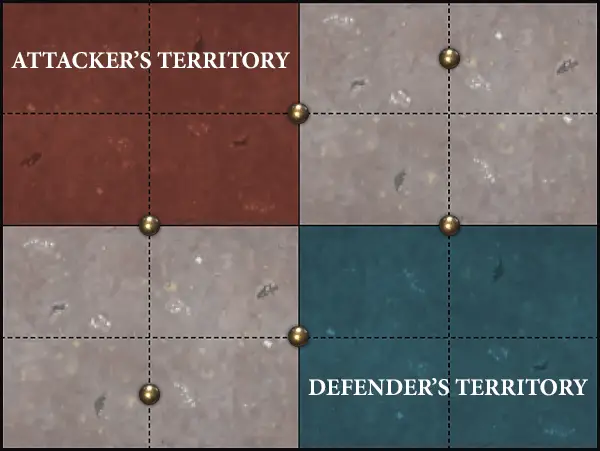 | ||
Battleplan Lines of Communication 3 3Cut off from civilisation, communication has never been more important. To win this battle, you must use your isolation against your foe and force them to break in confusion. THE ARMIES Each player picks an army and then they roll off. The winner chooses which player is the attacker and which is the defender.THE BATTLEFIELD The defender sets up the battlefield. First, they set up objectives as shown on the map. Then, they set up the recommended number of terrain features shown on the Pitched Battles table.DEPLOYMENT The attacker picks which territory is their territory. The other territory is the defender’s territory. The players then use alternating deployment, starting with the attacker. Each player must set up their units wholly within their territory.DISRUPTION At the start of each battle round, after determining which player will take the first turn, the player taking the second turn can pick a phase to disrupt (e.g. the hero phase). During that battle round, each time a model in their opponent’s army issues a command in that phase, their opponent must roll a dice. On a 3+, an additional command point must be spent in order to issue that command.Their opponent can choose whether or not to spend the additional command point. If they choose not to spend the additional command point, that command is not received (the command ability still counts as having been used) and the command point that was spent to issue that command is lost. VICTORY POINTS Each player scores victory points at the end of each of their turns as follows:- Score 1 victory point if you control at least one objective. - Score 1 victory point if you control two or more objectives. - Score 1 victory point if you control more objectives than your opponent. - Score 2 victory points if you completed the battle tactic you picked that turn. GRAND STRATEGY Each player scores 3 victory points at the end of the battle if they completed their grand strategy.BATTLE LENGTH The battle lasts for 5 battle rounds.GLORIOUS VICTORY The player with the most victory points at the end of the battle wins a major victory.If the players are tied on victory points at the end of the battle, then the player who completed the most battle tactics wins a minor victory. If both players completed the same number of battle tactics, then if only one player completed their grand strategy, that player wins a minor victory. If both players or neither player completed their grand strategy, the battle is a draw. 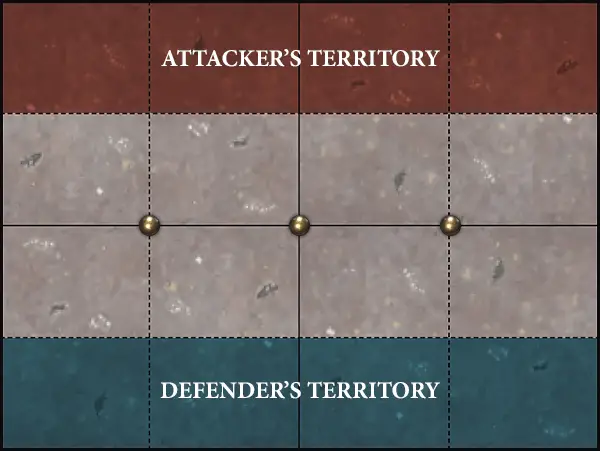 | ||
Battleplan Every Step is Forward 4 4The path to victory has been wracked with vicious sentient cyclones, pushing those who would conquer Andtor into close quarters. You will not be able to escape and press on unless you confront your foes once and for all. THE ARMIES Each player picks an army and then they roll off. The winner chooses which player is the attacker and which is the defender.THE BATTLEFIELD The defender sets up the battlefield. First, they set up objectives as shown on the map. Then, they set up the recommended number of terrain features shown on the Pitched Battles table.DEPLOYMENT The attacker picks which territory is their territory. The other territory is the defender’s territory. The players then use alternating deployment, starting with the attacker. Each player must set up their units wholly within their territory and more than 9" from enemy territory.GIVE NO GROUND If a unit makes a charge move, until the end of that turn, add 1 to the number of models that each model in that unit counts as for the purposes of contesting objectives. If a unit retreats, until the end of that turn, models in that unit cannot contest objectives.VICTORY POINTS Each player scores victory points at the end of each of their turns as follows:- Score 1 victory point if you control at least one objective. - Score 1 victory point if you control two or more objectives. - Score 1 victory point if you control more objectives than your opponent. - Score 2 victory points if you completed the battle tactic you picked that turn. GRAND STRATEGY Each player scores 3 victory points at the end of the battle if they completed their grand strategy.BATTLE LENGTH The battle lasts for 5 battle rounds.GLORIOUS VICTORY The player with the most victory points at the end of the battle wins a major victory.If the players are tied on victory points at the end of the battle, then the player who completed the most battle tactics wins a minor victory. If both players completed the same number of battle tactics, then if only one player completed their grand strategy, that player wins a minor victory. If both players or neither player completed their grand strategy, the battle is a draw. 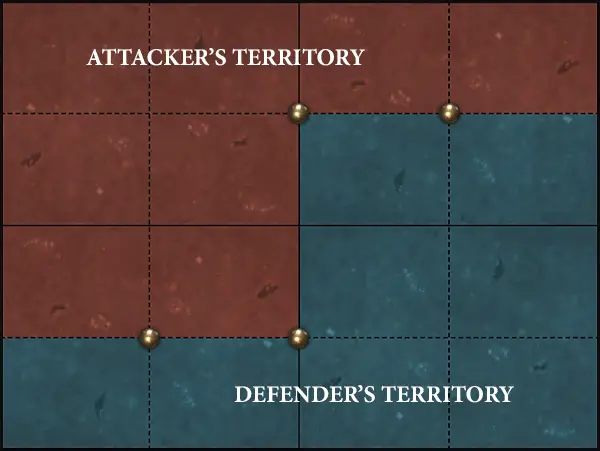 | ||
Battleplan Limited Resources 5 5Andtor’s shifting plains beat with frigid power. Now many seek to seize and harness such an energy source to freeze their foes solid. Claim the pulse for your own – or your own warriors may be next. THE ARMIES Each player picks an army and then they roll off. The winner chooses which player is the attacker and which is the defender.THE BATTLEFIELD The defender sets up the battlefield. First, they set up objectives as shown on the map. Then, they set up the recommended number of terrain features shown on the Pitched Battles table.DEPLOYMENT The attacker picks which territory is their territory. The other territory is the defender’s territory. The players then use alternating deployment, starting with the attacker. Each player must set up their units wholly within their territory and more than 9" from enemy territory.SIPHON MELTWATER When a player gains control of an objective, they start to siphon meltwater from it. After scoring victory points, if the player whose turn it is controls an objective that they controlled at the end of their previous turn, they have siphoned all the meltwater from that objective. For the rest of the battle, that player cannot control that objective.Designer’s Note: Once a player has siphoned all the meltwater from an objective, they can still contest it to prevent their opponent from controlling it, but they do not count as controlling it themselves. VICTORY POINTS Each player scores victory points at the end of each of their turns as follows:- Score 1 victory point if you control at least one objective. - Score 1 victory point if you control two or more objectives. - Score 1 victory point if you control more objectives than your opponent. - Score 2 victory points if you completed the battle tactic you picked that turn. GRAND STRATEGY Each player scores 3 victory points at the end of the battle if they completed their grand strategy.BATTLE LENGTH The battle lasts for 5 battle rounds.GLORIOUS VICTORY The player with the most victory points at the end of the battle wins a major victory.If the players are tied on victory points at the end of the battle, then the player that completed the most battle tactics wins a minor victory. If both players completed the same number of battle tactics, then if only one player completed their grand strategy, that player wins a minor victory. If both players or neither player completed their grand strategy, the battle is a draw. 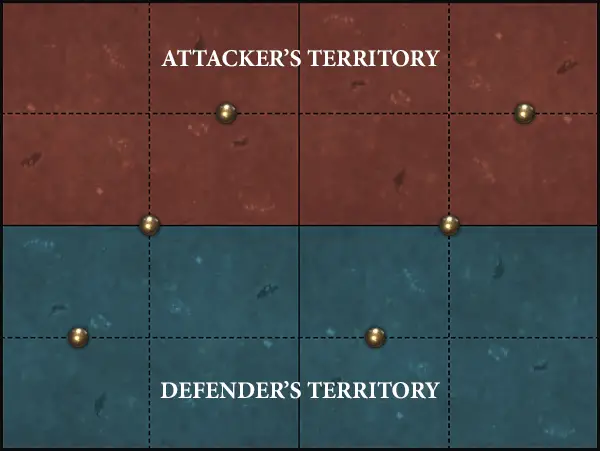 | ||
Battleplan Spring the Trap 6 6Out on the tundra, enchanted snowstorms howl constantly and shelter is sparse. With the only safe camp for miles around resting in a valley’s glacial craw, it is up to you to eliminate any rival armies seeking to use it for themselves – or face a frigid and painfully slow death above ground. THE ARMIES Each player picks an army and then they roll off. The winner chooses which player is the attacker and which is the defender.THE BATTLEFIELD The defender sets up the battlefield. First, they set up objectives as shown on the map. Then, they set up the recommended number of terrain features shown on the Pitched Battles table.DEPLOYMENT The attacker picks which territory is their territory. The other territory is the defender’s territory. The players then use alternating deployment, starting with the attacker. Each player must set up their units wholly within their territory and more than 9" from enemy territory.OUTFLANK During deployment, after both players have set up their units, starting with the attacker, each player can remove D3 friendly units from the battlefield (roll once for both players) and place those units in reserve. Starting from the second battle round, at the end of your movement phase, you can set up those units you placed in reserve wholly within 6" of the battlefield edge and more than 9" from all enemy units.VICTORY POINTS Each player scores victory points at the end of each of their turns as follows:- Score 1 victory point if you control at least one objective. - Score 1 victory point if you control two or more objectives. - Score 1 victory point if you control more objectives than your opponent. - Score 2 victory points if you completed the battle tactic you picked that turn. GRAND STRATEGY Each player scores 3 victory points at the end of the battle if they completed their grand strategy.BATTLE LENGTH The battle lasts for 5 battle rounds.GLORIOUS VICTORY The player with the most victory points at the end of the battle wins a major victory.If the players are tied on victory points at the end of the battle, then the player that completed the most battle tactics wins a minor victory. If both players completed the same number of battle tactics, then if only one player completed their grand strategy, that player wins a minor victory. If both players or neither player completed their grand strategy, the battle is a draw. 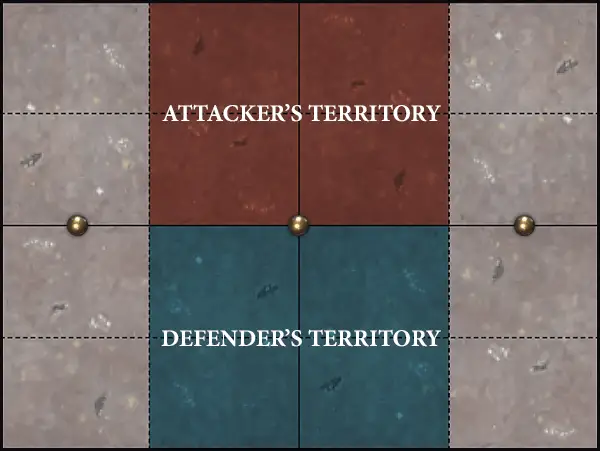 | ||
Battleplan Fountains of Frost 1 1Sometimes, the prize proves just as dangerous as the enemy. Seize Andtor’s geysers of pure magic, or freeze your warriors solid trying. THE ARMIES Each player picks an army and then they roll off. The winner chooses which player is the attacker and which is the defender.THE BATTLEFIELD The defender sets up the battlefield. First, they set up objectives as shown on the map. Then, they set up the recommended number of terrain features shown on the Pitched Battles table.DEPLOYMENT The attacker picks which territory is their territory. The other territory is the defender’s territory. The players then use alternating deployment, starting with the attacker. Each player must set up their units wholly within their territory.GEYSERS OF PRIMAL MAGIC ANDTORIAN LOCUS units count as 10 models for the purposes of contesting objectives. At the start of each battleshock phase, roll a dice for each objective that is contested by 3 or more units. On a 4+, each unit contesting that objective suffers D3 mortal wounds (roll separately for each unit).VICTORY POINTS Each player scores victory points at the end of each of their turns as follows:- Score 1 victory point if you control at least one objective. - Score 1 victory point if you control two or more objectives. - Score 1 victory point if you control more objectives than your opponent. - Score 2 victory points if you completed the battle tactic you picked that turn. GRAND STRATEGY Each player scores 3 victory points at the end of the battle if they completed their grand strategy.BATTLE LENGTH The battle lasts for 5 battle rounds.GLORIOUS VICTORY The player with the most victory points at the end of the battle wins a major victory.If the players are tied on victory points at the end of the battle, then the player that completed the most battle tactics wins a minor victory. If both players completed the same number of battle tactics, then if only one player completed their grand strategy, that player wins a minor victory. If both players or neither player completed their grand strategy, the battle is a draw. 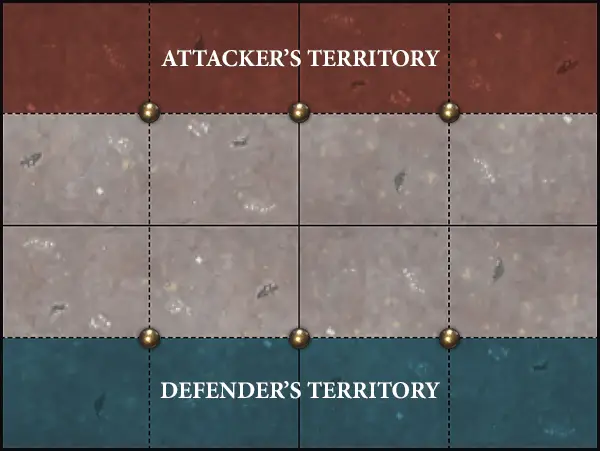 | ||
Battleplan The Icefields 2 2Andtor will not allow armies to claim its bounty so easily. As you meet your rivals in battle, you may find the land hungering to join the fight as well... THE ARMIES Each player picks an army and then they roll off. The winner chooses which player is the attacker and which is the defender.THE BATTLEFIELD The defender sets up the battlefield. First, they set up objectives as shown on the map. Then, they set up the recommended number of terrain features shown on the Pitched Battles table.DEPLOYMENT The attacker picks which territory is their territory. The other territory is the defender’s territory. The players then use alternating deployment, starting with the attacker. Each player must set up their units wholly within their territory and more than 9" from enemy territory.ICE-ENCRUSTED DOMAIN Each time a unit runs, it suffers D3 mortal wounds. When you make a charge roll for a unit, for each dice that shows a 1 before modifiers are applied, that unit suffers D3 mortal wounds.VICTORY POINTS Each player scores victory points at the end of each of their turns as follows:- Score 1 victory point if you control at least one objective. - Score 1 victory point if you control two or more objectives. - Score 1 victory point if you control more objectives than your opponent. - Score 2 victory points if you completed the battle tactic you picked that turn. GRAND STRATEGY Each player scores 3 victory points at the end of the battle if they completed their grand strategy.BATTLE LENGTH The battle lasts for 5 battle rounds.GLORIOUS VICTORY The player with the most victory points at the end of the battle wins a major victory.If the players are tied on victory points at the end of the battle, then the player that completed the most battle tactics wins a minor victory. If both players completed the same number of battle tactics, then if only one player completed their grand strategy, that player wins a minor victory. If both players or neither player completed their grand strategy, the battle is a draw. 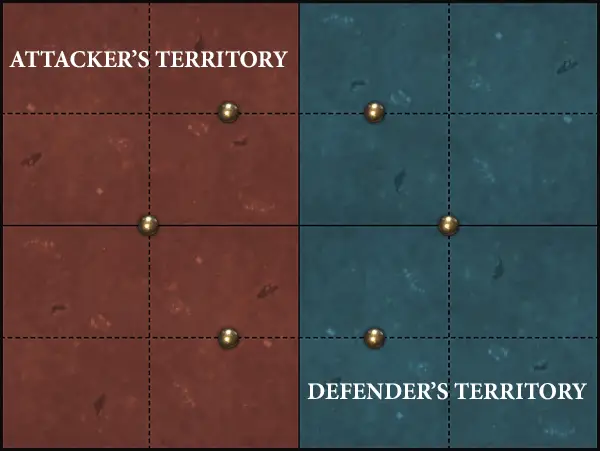 | ||
Battleplan Power Flux 3 3Across the realms, mages and sorcerers hunt the sites of pure power that birthed the incarnates – and in Andtor, many such sites lie temptingly unclaimed. THE ARMIES Each player picks an army and then they roll off. The winner chooses which player is the attacker and which is the defender.THE BATTLEFIELD The defender sets up the battlefield. First, they set up objectives as shown on the map. Then, they set up the recommended number of terrain features shown on the Pitched Battles table.DEPLOYMENT The attacker picks which territory is their territory. The other territory is the defender’s territory. The players then use alternating deployment, starting with the attacker. Each player must set up their units wholly within their territory and more than 9" from enemy territory.AETHER SURGES In this battle, players can only score victory points for objectives they control if the objective has been activated.At the start of each battle round, after determining which player will take the first turn, the player taking the second turn must choose which pair of objectives (either A or B) are activated for that battle round. VICTORY POINTS Each player scores victory points at the end of each of their turns as follows:- Score 1 victory point if you control at least one activated objective. - Score 1 victory point if you control both activated objectives. - Score 1 victory point for each activated objective you control that is contested by a friendly ANDTORIAN LOCUS and that has no enemy ANDTORIAN LOCUS units contesting it. - Score 1 victory point if any enemy WIZARD HERO units were destroyed in that battle round. This victory point is scored at the end of the battle round instead of at the end of each turn. - Score 2 victory points if you completed the battle tactic you picked that turn. GRAND STRATEGY Each player scores 3 victory points at the end of the battle if they completed their grand strategy.BATTLE LENGTH The battle lasts for 5 battle rounds.GLORIOUS VICTORY The player with the most victory points at the end of the battle wins a major victory.If the players are tied on victory points at the end of the battle, then the player who completed the most battle tactics wins a minor victory. If both players completed the same number of battle tactics, then if only one player completed their grand strategy, that player wins a minor victory. If both players or neither player completed their grand strategy, the battle is a draw. 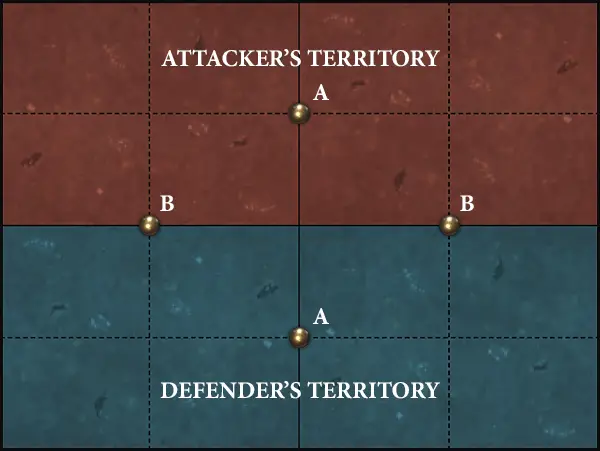 | ||
Battleplan The Frigid Zephyr 4 4As you clash in battle, you must contend with the freezing squalls belched straight from Andtor’s frigid lungs. This continent is hostile, and those who fail to adapt will perish. THE ARMIES Each player picks an army and then they roll off. The winner chooses which player is the attacker and which is the defender.THE BATTLEFIELD The defender sets up the battlefield. First, they set up objectives as shown on the map. Then, they set up the recommended number of terrain features shown on the Pitched Battles table.DEPLOYMENT The attacker picks which territory is their territory. The other territory is the defender’s territory. The players then use alternating deployment, starting with the attacker. Each player must set up their units wholly within their territory and more than 9" from enemy territory.FEROCIOUS SQUALL At the start of the battle, the battlefield is affected by a squall. Until the squall dissipates, units more than 12" apart are not visible to each other. In addition, until the squall dissipates, models cannot fly. At the start of each battle round after the first, after determining which player will take the first turn, if the squall has not dissipated, the player taking the second turn rolls a dice and adds the number of the current battle round to the score. On a 7+, the squall dissipates.VICTORY POINTS Each player scores victory points at the end of each of their turns as follows:- Score 1 victory point if you control at least one objective. - Score 1 victory point if you control two or more objectives. - Score 1 victory point if you control more objectives than your opponent. - Score 2 victory points if you completed the battle tactic you picked that turn. GRAND STRATEGY Each player scores 3 victory points at the end of the battle if they completed their grand strategy.BATTLE LENGTH The battle lasts for 5 battle rounds.GLORIOUS VICTORY The player with the most victory points at the end of the battle wins a major victory.If the players are tied on victory points at the end of the battle, then the player who completed the most battle tactics wins a minor victory. If both players completed the same number of battle tactics, then if only one player completed their grand strategy, that player wins a minor victory. If both players or neither player completed their grand strategy, the battle is a draw. 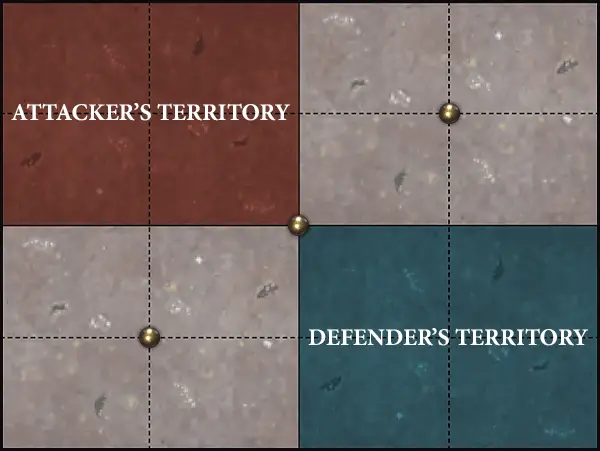 | ||
Battleplan No Reward Without Risk 5 5This site is suffused with power that courses through the veins of magic-users as easily as breathing. Slaying wizards here is a dangerous task, for Andtor’s might thrums under their skin and threatens to tear them apart. THE ARMIES Each player picks an army and then they roll off. The winner chooses which player is the attacker and which is the defender.THE BATTLEFIELD The defender sets up the battlefield. First, they set up objectives as shown on the map. Then, they set up the recommended number of terrain features shown on the Pitched Battles table.DEPLOYMENT The attacker picks which territory is their territory. The other territory is the defender’s territory. The players then use alternating deployment, starting with the attacker. Each player must set up their units wholly within their territory.FEEDBACK OVERLOAD When a WIZARD HERO is slain, before removing that model from play, roll a dice. On a 4+, the WIZARD explodes as their magical energies are released uncontrollably. Each unit within a number of inches equal to the Wounds characteristic of that WIZARD suffers D3 mortal wounds (roll separately for each unit).VICTORY POINTS Each player scores victory points at the end of each of their turns as follows:- Score 1 victory point if you control at least one objective. - Score 1 victory point if you control two or more objectives. - Score 1 victory point if you control more objectives than your opponent. - Score 2 victory points if you completed the battle tactic you picked that turn. GRAND STRATEGY Each player scores 3 victory points at the end of the battle if they completed their grand strategy.BATTLE LENGTH The battle lasts for 5 battle rounds.GLORIOUS VICTORY The player with the most victory points at the end of the battle wins a major victory.If the players are tied on victory points at the end of the battle, then the player who completed the most battle tactics wins a minor victory. If both players completed the same number of battle tactics, then if only one player completed their grand strategy, that player wins a minor victory. If both players or neither player completed their grand strategy, the battle is a draw. 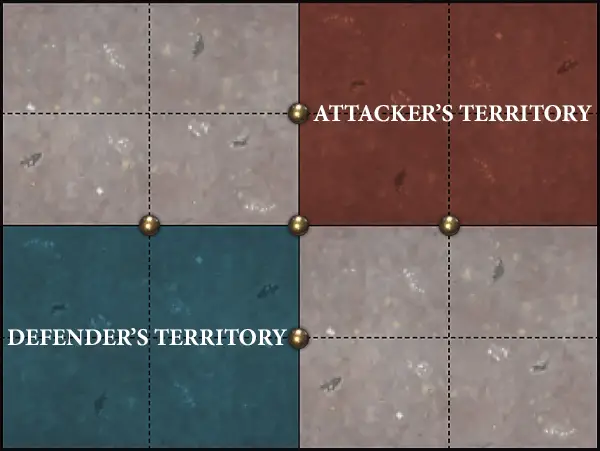 | ||
Battleplan Towers in the Tundra 6 6Andtor’s vast, unclaimed swathes of arcane land are a tempting prospect indeed. You are not the first to set foot here, as the ruins of the wizards that came before still dot the landscape. Seizing such magic-saturated sites will be vital – as will plundering their forgotten treasures. THE ARMIES Each player picks an army and then they roll off. The winner chooses which player is the attacker and which is the defender.THE BATTLEFIELD The defender sets up the battlefield. First, they set up objectives as shown on the map. Then, they set up the recommended number of terrain features shown on the Pitched Battles table. At least 1 defensible terrain feature that is neither large nor very large must be set up wholly within each territory and more than 9" from enemy territory.Designer’s Note: If you do not have any defensible terrain features, the defender must pick 2 terrain features that are neither large nor very large to be treated as defensible in this battleplan. DEPLOYMENT The attacker picks which territory is their territory. The other territory is the defender’s territory. Each player chooses 1 defensible terrain feature or faction terrain feature wholly within their territory to represent a Wizards’ Tower. Wizards’ Towers have the Arcane scenery rule (28.1.3) in addition to any other scenery rules they have.VICTORY POINTS Each player scores victory points at the end of each of their turns as follows:- Score 1 victory point if you control at least one objective. - Score 1 victory point if you control both objectives. - Score 2 victory points if you completed the battle tactic you picked that turn. Each player scores victory points at the end of the battle as follows: - Score 2 victory points if you control the Wizards’ Tower in your territory. - Score 2 victory points if there are no enemy units contesting the Wizard’s Tower in enemy territory. GRAND STRATEGY Each player scores 3 victory points at the end of the battle if they completed their grand strategy.BATTLE LENGTH The battle lasts for 5 battle rounds.GLORIOUS VICTORY The player with the most victory points at the end of the battle wins a major victory.If the players are tied on victory points at the end of the battle, then the player who completed the most battle tactics wins a minor victory. If both players completed the same number of battle tactics, then if only one player completed their grand strategy, that player wins a minor victory. If both players or neither player completed their grand strategy, the battle is a draw. 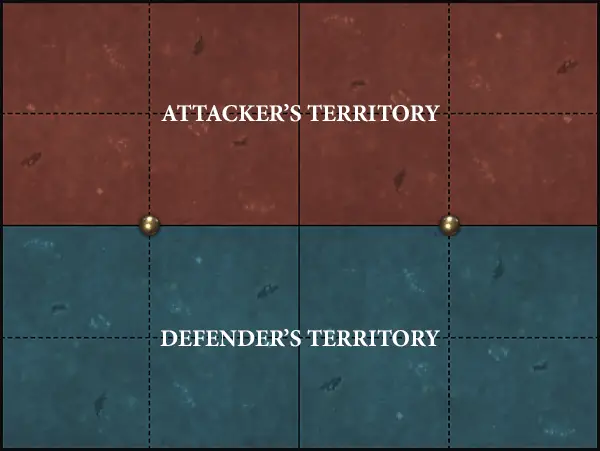 | ||
Pitched Battle Publications 2023-24
As Warhammer Age of Sigmar continues to grow, naturally we will continue to write rules for the game. However, when you are playing competitively, sometimes it’s hard to know which of these rules are ‘legal’ - in other words, which rules you can use in Pitched Battles. In this section we’ve provided a handy at-a-glance list which shows you all the publications whose rules you are allowed to use in Pitched Battles.Core
- Warhammer Age of Sigmar Core Book
- General’s Handbook: Pitched Battles 2023-24
- Pitched Battle Profiles 2023-24
Battletomes
- Battletome: Beasts of Chaos
- Battletome: Blades of Khorne
- Battletome: Cities of Sigmar
- Battletome: Daughters of Khaine
- Battletome: Disciples of Tzeentch
- Battletome: Flesh-eater Courts
- Battletome: Fyreslayers
- Battletome: Gloomspite Gitz
- Battletome: Hedonites of Slaanesh
- Battletome: Idoneth Deepkin
- Battletome: Kharadron Overlords
- Battletome: Lumineth Realm-lords
- Battletome: Maggotkin of Nurgle
- Battletome: Nighthaunt
- Battletome: Ogor Mawtribes
- Battletome: Orruk Warclans
- Battletome: Ossiarch Bonereapers
- Battletome: Seraphon
- Battletome: Skaven
- Battletome: Slaves to Darkness
- Battletome: Sons of Behemat
- Battletome: Soulblight Gravelords
- Battletome: Stormcast Eternals
- Battletome: Sylvaneth
Expansions
- Broken Realms: Morathi
- Broken Realms: Teclis
- Broken Realms: Be’lakor
- Broken Realms: Kragnos
- Season of War: Thondia
- Dawnbringers Book I: Harbingers
- Dawnbringers Book II: Reign of the Brute
- Dawnbringers Book III: The Long Hunt
- Dawnbringers Book IV: The Mad King Rises
- Dawnbringers Book V: Shadow of the Crone
HERO that does not have the WIZARD, PRIEST or KHORNE keyword. The bearer becomes a WIZARD that can only cast Arcane Bolt, Mystic Shield and spells to summon endless spells on your army roster. They can attempt to cast 1 spell in your hero phase and attempt to unbind 1 spell in the enemy hero phase.
Designer’s Note: When using the Pitched Battles 2023-24 battlepack in the General’s Handbook, if a HERO with a Wounds characteristic of 9 or less is given the Arcane Tome, it gains the ANDTORIAN LOCUS keyword.
The AETHER-KHEMIST keyword is used in the following Kharadron Overlords warscrolls:
Spell in a Bottle
This Aether-Khemist has used the alchemical arts to transmute an endless spell into an inert gas and trap it in a specialised container. When the container is shattered, the endless spell is freed.AETHER-KHEMIST only. Pick 1 endless spell that does not belong to a faction. You can include that endless spell in your army without spending any points to do so. In addition, once per battle, in your hero phase, the bearer can automatically cast the spell that summons that endless spell (do not make a casting roll) and it cannot be unbound. However, the bearer cannot control that endless spell.
| Most rules for artefacts of power refer to the bearer. The bearer is the model to which an artefact of power has been given (see section 27.5.2 for some examples). | ||
When you set up a reserve unit, either during deployment or once the battle is underway, you must tell your opponent that the unit is in reserve and keep it to one side instead of placing it on the battlefield. At the start of the fourth battle round, units that are still in reserve are destroyed. Units cannot cast spells or use abilities while they are in reserve unless the spell or ability specifically says it can be used by reserve units.
| Reserve units are picked as part of your army before the battle begins, while summoned units are units added to your army once the battle is underway. Models that have been removed from play can be used as part of a summoned unit. | ||
The TRANSPORT VESSEL keyword is used in the following Kharadron Overlords warscrolls:
The LUMINETH REALM-LORDS keyword is used in the following Lumineth Realm-lords warscrolls:
To attempt to dispel an endless spell, pick 1 endless spell that is within 30" of a friendly WIZARD or friendly PRIEST and that is visible to them. Then make a dispelling roll by rolling 2D6. If the roll is greater than the casting value of that endless spell, it is dispelled and removed from play. An endless spell cannot be summoned again in the turn that it is removed from play.
Hand-carved Nullstone Icon
Skilfully sculpted and inscribed with powerful enchantments, this icon can be held aloft to undo volleys of sorcerous power.The bearer can attempt to unbind 1 spell or attempt to dispel 1 endless spell in the enemy hero phase in the same manner as a WIZARD. Each time the bearer successfully unbinds a spell or dispels an endless spell using this ability, the bearer can attempt to unbind 1 additional spell in that phase.
- Unit champions can issue commands to their own unit (see 22.3.2).
- HEROES can issue commands to units that are wholly within 12" of them.
- Generals can issue commands to units that are wholly within 18" of them.
- TOTEMS can issue commands to units that are wholly within 18" of them.
Mortal wounds caused while a unit is attacking are allocated at the same time as wounds caused by the unit’s attacks: after all of the unit’s attacks have been made. Mortal wounds caused at other times are allocated as soon as they are caused. Mortal wounds are allocated in the same way as wounds and are treated in the same manner as wounds for rules purposes.
Sometimes an ability will allow a single hit roll to score two or more hits. If this is the case, make all of the wound and save rolls for those hits at the same time.
| You do not have to pick a target for a charge attempt before making the charge roll. | ||
| In most cases, modifiers are cumulative. However, some dice rolls, such as hit and wound rolls, will specify that the roll cannot be modified by more than +1 or -1. When this is the case, add up all the modifiers that apply, and if the total is more than +1 or -1, treat it as being either +1 or -1 as appropriate. | ||
A flying model cannot finish a move on top of another model or finish a normal move, run or retreat within 3" of an enemy unit.
Contents | ||
 1.1
1.1 